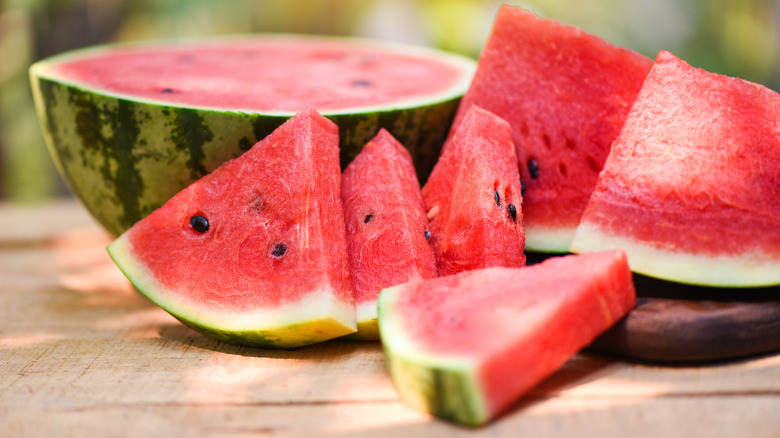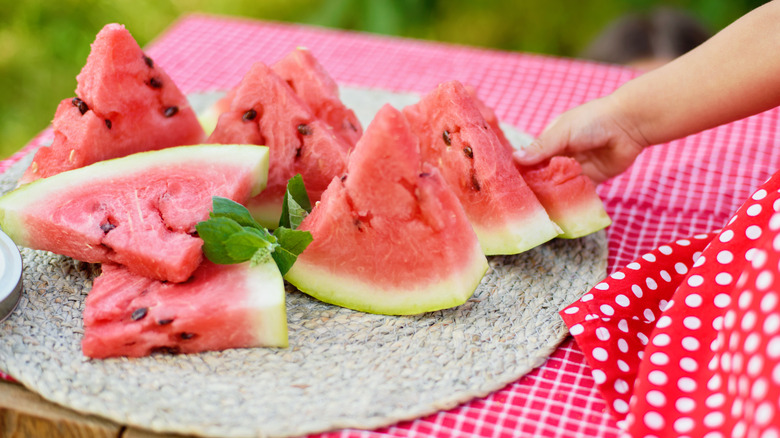The Best Ways To Store Watermelon
You wait all year for the first plump, juicy watermelons to hit roadside stands or grocery-store produce sections. Suddenly, there they are; lined up like sentinels of summer. You crack one open and dive into ultimate freshness — but that joy can fade quickly unless you know how to keep it that way. After all, part of the fun is having ready-to-eat slices waiting in your refrigerator on a warm, sunny afternoon.
Most watermelons last up to four weeks once they're plucked from the vine, according to the Watermelon Board in Florida. But that doesn't necessarily mean you have that long once you bring it home. After all, most melons take quite a journey from the field to the fridge or your waiting picnic table. The best way to store a watermelon begins by selecting the freshest one with the least amount of obvious damage incurred en route to the grocery store.
Choosing the best watermelon before storing
Before storing a watermelon for ultimate longevity, take some time at the point of purchase to inspect each luscious-looking candidate. They might not be so tasty on the inside if the outside shows damage. That means checking for signs of excessive or rough handling, including bruises, dings, or discolored, "mushy" indentions indicating decay. The Colorado Department of Education (CDE) warns that decay or damage on the rinds may harbor bacteria that could be dangerous. If you do end up with a damaged melon, wash and scrub it before you cut and then carve out the affected areas. You don't want any bacteria transferring to the inner edible parts.
The Watermelon Board recommends using what it calls the "Look, Lift, Turn!" method. After looking for exterior damage, lift the melon to check its weight. Since an average watermelon is about 92% water (hence the name), you want it to feel very heavy. Next up is carefully turning it to view the underside. Keep that heaviness in mind, though — you probably don't want to be holding it while performing this step. Just gently roll it over on its side and look for the faded yellow or light tan spot indicating that it laid in the warm sun while ripening in the field. If you're a thumper, listen for a dull sound rather than a ringing one.
How to store a watermelon before and after cutting
We all assume that a watermelon immediately earns a prime (albeit large) spot in the refrigerator. But that's not always the case. If the whole, uncut watermelon is field-fresh and has yet to enter the "cold chain" during its journey to you, there is no need to refrigerate it right away, per the Watermelon Board. However, once it has entered cold storage on refrigerated transportation trucks or in grocery stores, it must continue to remain refrigerated.
Temperature matters. The CDE guidelines note that uncut watermelons stored at temperatures between 50 and 60 degrees F have the ultimate longevity of up to three weeks. That also generally requires a relative humidity level of 90%. Higher storage temperatures outside the fridge greatly reduce shelf life, with up to 75 degrees F cutting edible viability to as low as 10 days, and above 75 degrees F cutting that in half again. Once cut, the CDE recommends consuming covered, refrigerated watermelon within 24 hours and unrefrigerated cut slices within two hours unless kept at temps below 41 degrees F.
One last consideration: Did you know that storing a watermelon next to fruits such as apples, pears, plums, and bananas can cause it to degrade more rapidly? That's because those fruits emit high levels of ethylene gas that can affect ethylene-sensitive produce such as watermelons, according to Livestrong.
Now that you know the proper way to store a watermelon, you can indulge in this sweet summer treat.


